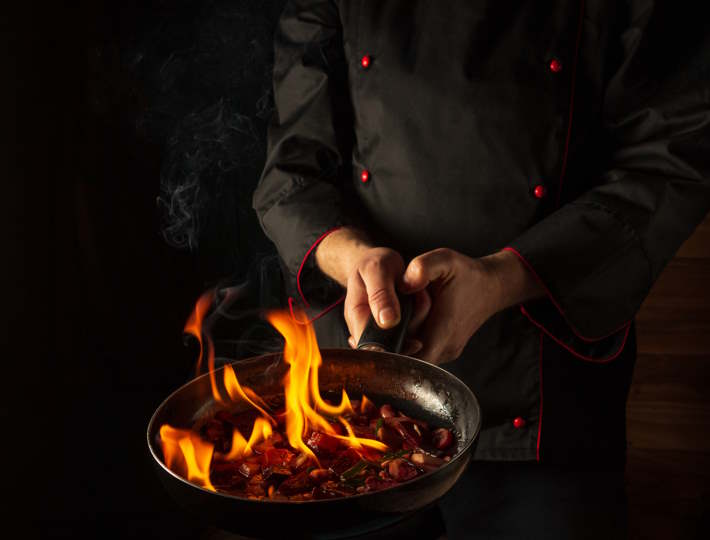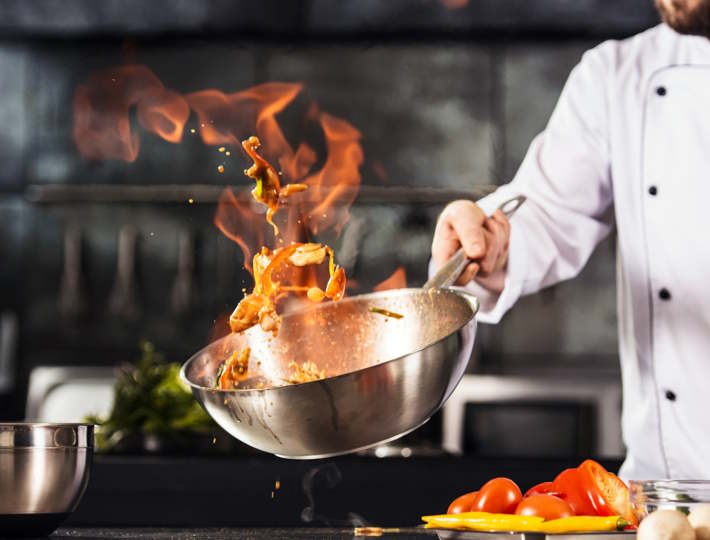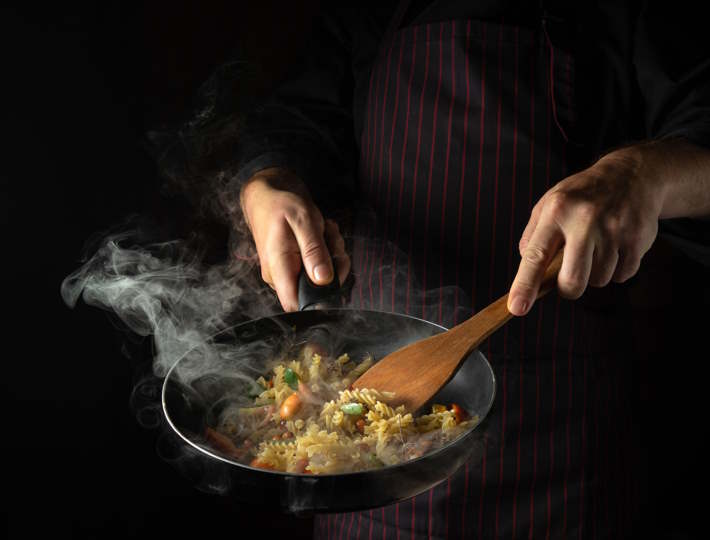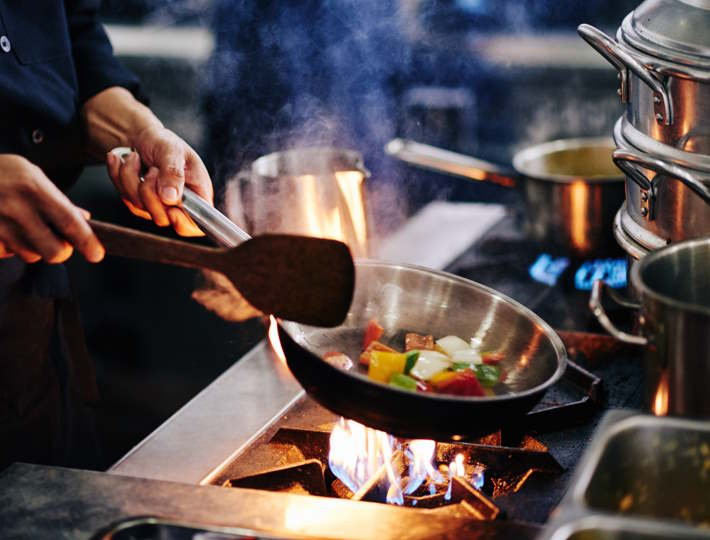How Hot Does a Frying Pan Get? – 10 Delicious Questions Answered
Frying pans are an essential tool in the kitchen, but knowing the right temperature to cook at can be confusing. Some recipes call for medium heat, while others require a higher heat setting. If you’re not sure what temperature a frying pan should be in Celsius, read on. In this blog post, we’ll take a closer look at the various heat settings you need to know to cook up the perfect dishes every time.
Whether you’re a home cook or a professional chef, this guide will help you maneuver the heat settings with ease. On the other hand, if the oil is added to an overheated pan, it will burn, and the food quality will be reduced again. To understand the question “How hot does a frying pan get?” it is necessary to look at the heating degree of a frying pan on medium.
How Hot Is A Frying Pan on Medium?

There are three different temperatures, low, medium, and high heat, where the frying pans can be used according to their intended use. While low heat is ideal for cooking foods such as fish or vegetables, high heat is the temperature that can be used to sear the steak faster. On the other hand, as the more common cooking degree, medium heat is best for eggs, meat products, vegetables, and many other types of ingredients.
So how hot does a frying pan get on medium, and how do we know when the pan has reached this average temperature?
First of all, since the temperature that the frying pans can reach may vary according to the production material, to give a general value, the highest temperature it can reach can be 600°F, that is, 315°C. When we return to our main question in the face of these values, the ideal temperature that the frying pan can reach on the medium will be between 300°F and 400°F (148°C-204°C).
On the other hand, having professional kitchen thermometers to understand the oil and pan temperature can make your job very practical. However, in the absence of such equipment, it is possible to understand both the pan and oil temperature through quick hints. The most common of these tips is to add a small amount of water to the pan. If the water added to the heated pan starts to evaporate and bubble, the pan has reached a temperature between 200°F and 300°F, which is called low temperature.
To understand that it has reached 300°F-400°F, namely medium heat, the water added to the pan must form one or two beads. At this stage, you need to know that the pan is ready for adding oil. But keep in mind that if you expose the pan to heat for more than a minute or two, it will overheat.
As for understanding whether the pan is overheated, that is, whether it is high heat at a temperature between 500°F-600°F (260°C-315°C), it may be helpful to observe the water forms created for medium heat spread around by creating more forms among themselves.
How Hot Is A Frying Pan On High?
Do you ever wonder how hot your frying pan gets when you set it on high? Cooking can be a lot of fun, but it can also be dangerous if you don’t know the temperatures you’re working with. In this blog post, we will explore just how hot a frying pan gets when it is on high.
First and foremost, it is important to understand that heat settings can vary depending on the stove and pan you are using. But generally, when you set your stove to its highest setting, it will get up to around 500°F (260°C) or higher. This means that your frying pan will be extremely hot and can burn food quickly if you’re not careful.
It’s also important to note that the temperature of your frying pan can vary depending on whether you have something in it or not. When a frying pan is empty, it can heat up very quickly, and the temperature can fluctuate quite a bit. But when you add food to the pan, the temperature will cool down slightly, so don’t be afraid to adjust the heat as you go.
| Frying Pan Heat Settings | Fahrenheit | Celsius |
|---|---|---|
| Low Heat | 225°F | 110°C |
| Medium Heat | 325°F | 160°C |
| Medium-High Heat | 375°F | 190°C |
| High Heat | 500°F or higher | 260°C or higher |
If you’re worried about your frying pan getting too hot, you can always use a thermometer to check the temperature. This can be particularly useful if you’re working with delicate foods such as fish or eggs, which can burn easily if the pan is too hot.
What Temperature Should A Frying Pan Be In Celsius?
When it comes to cooking, there are a lot of factors that come into play to make sure that your food is cooked perfectly. One of those factors is the temperature of your pan. But what temperature should a frying pan be in Celsius?
First of all, it’s important to consider what type of food you’re cooking. Different foods require different temperatures. For example, if you’re frying eggs or pancakes, you’ll want your pan to be at a lower temperature, around 120-150°Celsius, so that they cook evenly without burning or sticking. On the other hand, if you’re searing a steak or cooking a stir-fry, you’ll want your pan to be much hotter, around 200-230°Celsius.
It’s also important to note that the thickness and material of your pan can affect the temperature. Thicker pans will retain heat better, so you may need to adjust your temperature accordingly. Non-stick pans, on the other hand, tend to heat up quickly, so you may want to lower your heat slightly to prevent your food from burning.
One way to test the temperature of your pan is to sprinkle some water onto it. If the water sizzles and evaporates almost immediately, your pan is hot enough. If it just sits there, your pan is still too cool. However, be careful when doing this test as hot oil or a hot pan can be dangerous.
- In summary, the temperature of your frying pan in Celsius varies depending on the type of food you’re cooking.
- Eggs and pancakes require a lower temperature of around 120-150°Celsius, while steaks and stir-fries require a higher temperature of around 200-230°Celsius.
- The thickness and material of your pan can also affect the temperature, so it’s important to adjust accordingly.
How Hot Does A Cast Iron Pan Get?
Cast iron pans are created by pouring molten iron into a single piece in the form of pans or pots, and these pans retain heat for a long time due to their structure. Similarly, the heat is evenly distributed around the surface of the pan. Due to their long-term heat retention, cast-iron pans can reach very high temperatures. On the other hand, the pan loses a great deal of heat through the ingredient added to the surface of the pan, making it ideal for searing.
So, what is the highest temperature that cast iron pans can reach?
We have said that depending on the type of frying pans, the highest temperature that can be reached makes a difference; accordingly, it is known that 600°F as the maximum temperature can reach 700°F to 1500°F in cast-iron pans. Accordingly, cast-iron pans are very suitable for processes such as deep-frying, as they can reach such a high temperature and hold the temperature mentioned before. Since they are the perfect pan type to create a golden brown crust in food, they can produce delicious products at the appropriate temperature setting.
Certain types can be applied in order not to shorten the life of cast-iron pans and not to reduce the quality of the food. For example, cast-iron pans must be adequately and properly heated before use, just like any other type of frying pan. In addition, it should not be forgotten that cast-iron pans heat up later than other pans due to their structure and material.
Accordingly, approximately 10 minutes of pre-heating is required from low to medium temperature for a sufficiently and evenly heated cast-iron pan. Otherwise, the pan, which comes into direct contact with high heat, will be damaged by being exposed to a phenomenon, namely, thermal shock.
Speaking of high temperatures, we said that cast-iron pans can easily be exposed to high temperatures and can hold heat for a long time. However, this grade should not be processed directly into the pan, depending on the intended use. Otherwise, as mentioned above, the pan will be damaged and on the other hand, the ingredient added to the pan will burn eventually. In case of overheating of the cast pan, turn off the heat and allow the pan to cool for a while to a certain temperature.
How Hot Does A Pan on A Gas Stove Get?

Before going into detail, gas stoves usually have four different temperature settings: simmer, low, medium, and high. These settings can typically vary with the cooking technique of the dish to be made. Accordingly, the heating values associated with the type of pan may change, as well as the temperature setting may vary depending on the quality of the stove used on the gas stove.
Supportively, the temperature values to be given in answer to the question “How hot does a frying pan get on a gas stove?” is discussed under the general framework. That is to say, the temperature given at the simmer setting corresponds to 140°F heating of the pan. This type of heating setting is mostly used for heating food rather than cooking.
Or, it can be used for melting cheese and seasoning soups. Additionally, in the low-heat option of a gas stove, frying pans meet temperatures between 200°F-300°F. This type of warming process would be ideal for cooking with a slow cooking technique.
On the other hand, a frying pan heated to the medium setting of the gas stove will heat between 300°F-400°F. This temperature is ideal for cooking omelets, pancakes, vegetables, chicken, or steak. In the high heat of gas stoves, frying pans rise to a temperature between 400°F-600°F. If it is higher than this value, serious burns occur in the pan and the food. This temperature is more suitable for searing the meat in cast-iron pans.
Do High Heat Ruin Pans?
After talking about the points that can be considered in the heat adjustment and the temperatures that the pans can reach, it will be beneficial to talk about what effects long-term and high temperatures have on the pans and what kind of way should be followed against these effects.
We mentioned that high heat is often an effective method of searing meat. In this regard, the taste quality of the food cooked at high temperatures will decrease, and the risk of burning is quite high. But if we extend the framework to pans rather than food quality, you can be sure that high heat will have very expensive consequences as well.
If the layers of the materials on the surface of the pan are exposed to high temperatures for a long time, and frequently, they thin out and, eventually, reduce the quality of the pan. Besides, the fact that many pans, especially non-sticks, chemically reveal harmful toxins while cooking because of being worn out by overheating is also very risky in terms of health.
On the other hand, your pan will likely be damaged due to long-term exposure to high temperatures, with the formation of a spreading stain starting from the lower parts, along with cracks. Apart from these, cast-iron frying pans, as a type of pan that can reach very high temperatures and maintain a long-term temperature, shortens their life by facing cracks when it is outside of this temperature limit and exposed to this situation for a long time.
We said that high temperatures also reduce the quality of the food. That is, if oil is added to overheated pans, the ingredients will likely stick to the pan or become directly scorched if the oil burns on the overheated surface. In short, yes, high heat will damage your pans and ruin them.
How Hot Is Oil in a Frying Pan?

Speaking of oils, it’s a must to observe the heating state of the oil as well as adjust the pan temperature. The heating time of the oil on the frying pan is usually five minutes on medium heat. Depending on this time, different degrees of heating can be seen in oil types. That is, butter heats up at 248°F-302°F, corn oil at 410°F, olive oil at 405°F-428°F, and sunflower oil at 437°F.
The optimal oil frying temperature is to stay between 320°F and 374°F. It will be guaranteed that the foods fried or cooked between this temperature will be cooked without losing their texture, burning, absorbing the oil, or sticking to the pan.
The type of pan used in the process of heating the oil is also very important. For example, heat-resistant and non-stick pans or pots are prioritized for oil heating. Accordingly, we mentioned that the unheated oil will be absorbed by the ingredients and cause a bad taste and texture. Similarly, overheated oil, in other words, burnt oil, negatively affects the cooking process of the food.
You can use a wooden spoon to see if the oil is getting hot. After touching the tip of the spoon perpendicularly to the surface of the pan, you can see that many bubbles form around it, and you can understand that the oil is getting hot. If the bubbles are boiling hard and dense, this means that the oil is too hot. In such a case, you should let the oil get chill by waiting and then continue the cooking process.
How Hot Is A Frying Pan With Oil?
Have you ever wondered about the temperature of your frying pan when you cook? Knowing the right temperature for your frying pan can make a big difference in the outcome of your dish. And, what about the temperature of the frying pan with oil?
The temperature of a frying pan with oil can vary depending on the type of oil you use and how long the pan has been preheated. Generally, the temperature of a frying pan with oil can range from 300°F to 450°F.
To check the temperature of your frying pan with oil, you can use a kitchen thermometer. Simply insert the thermometer in the oil and wait for the reading. If you don’t have a thermometer, you can test the temperature of the oil by dropping a small piece of bread or a cube of tofu in the pan. If the bread turns golden brown or the tofu starts sizzling, then the oil is hot enough.
It’s important to note that different types of oil have different smoke points. The smoke point is the temperature at which the oil begins to smoke and break down, which can release harmful chemicals and affect the flavor of the food. For example, olive oil has a lower smoke point than vegetable oil, so it’s better suited for low-heat cooking or drizzling over food.
Here’s a table showing the smoke points of common cooking oils:
| Oil | Smoke Point (°F) |
|---|---|
| Vegetable Oil | 400-450 |
| Canola Oil | 400 |
| Peanut Oil | 450 |
| Olive Oil | 325-375 |
How Hot Is Too Hot for Non-stick Pans?

Non-stick pans are very effective and practical equipment in cooking as they are produced from materials that are generally resistant to friction, heat, moisture, and chemicals. Supportively, non-stick pans, which are durable in a temperature range of 620°F to -436°F, should not be exposed to high temperatures suddenly and continuously in order not to encounter thermal shock like all other pans. Before adding the ingredients, they should be heated slowly, starting with low heat.
On the other hand, when the temperature rises above a level such as 660°F, burns, and flames can occur in these pans. Although they are made of materials that can withstand very high temperatures, it is recommended to use non-stick pans at a maximum temperature not exceeding 500°F.
If the non-stick pan is overheated, the PTFE coating, also known as Teflon, will be damaged, resulting in thinning and consequently the pan losing its function. Eventually, the pan will start to smell plastic and will begin to emit toxic fumes that can cause polymer fever.
Conclusion
On the other hand, the ideal temperature for a medium-heated pan is 300°F-400°F. On the contrary, a high heat setting is preferred for the searing process rather than cooking, which is a level where the pan heats up between 400°F-600°F.
Considering these, high heat may vary depending on the type of pan. For example, cast-iron pans can reach a heating degree of up to 1500°F due to their high-temperature retention, while this figure is seen as a maximum of 640°F in non-stick pans.

